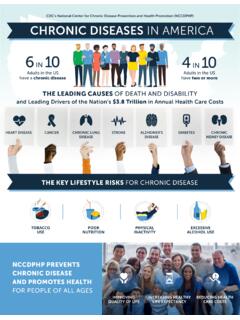Transcription of Screening for Prevention and Early Diagnosis of Cancer
1 Screening for Prevention and Early Diagnosis of Cancer Jane Wardle University College London Kathryn Robb University of Glasgow Sally Vernon University of Texas School of Public Health at Houston Jo Waller University College London The poor outcomes for cancers diagnosed at an advanced precursor stage ( , cervical intraepithelial neoplasia, stage have been the driver behind research into techniques colorectal polyps), removal of abnormal tissue prevents the to detect disease before symptoms are manifest. For cer- development of Cancer and could therefore be termed pri- vical and colorectal Cancer , detection and treatment of mary Prevention . Where the target is an Early -stage tumor precancers can prevent the development of Cancer , a ( , shown in mammography or fecal occult blood test- form of primary Prevention .)
2 For other cancers breast, ing), Screening is termed secondary Prevention because it is prostate, lung, and ovarian Screening is a form of sec- designed to improve long-term outcomes by treating the ondary Prevention , aiming to improve outcomes through Cancer when it is more likely to be localized. earlier Diagnosis . International and national expert orga- Cancer Screening nizations regularly assess the balance of benefits and harms of Screening technologies, issuing clinical guide- The first Cancer Screening test was developed by George lines for population-wide implementation. Psychological Papanicolaou, whose 1943 monograph provided a method research has made important contributions to this process, of identifying both precancerous and malignant cervical assessing the psychological costs and benefits of possible cells.
3 At around the same time, the value of x-rays to Screening outcomes ( , the impact of false positive re- diagnose Early breast cancers began to be recognized, with sults) and public tolerance of overdiagnosis. cervical , Screening mammography becoming a viable option once colorectal, and breast Screening are currently recom- lower dose x-ray machines were available. Guaiac had mended, and prostate, lung, and ovarian Screening are been used to detect occult blood lost from colorectal can- under active review. Once technologies and guidelines are cers in stool samples, but in 1958 Eric Mueller successfully in place, delivery of Screening is implemented according to impregnated guaiac resin onto a filter paper, which was the the health care system of the country, with invitation sys- basis of the commercially developed Hemoccult (fecal tems and provider recommendations playing a key role.)
4 Occult blood; FOB) test. Behavioral scientists can then investigate how individuals In 1968, the World Health Organization published a make Screening decisions, assessing the impact of knowl- set of criteria to guide decisions about whether to introduce edge, perceived Cancer risk, worry, and normative beliefs population-based Screening (Wilson & Jungner, 1968). about Screening , and this information can be used to de- They argued that for a Screening test to be worthwhile, the velop strategies to promote Screening uptake. This article condition being screened for must be an important public describes current Cancer Screening options, discusses be- health problem, whose natural history is well understood, havioral research designed to reduce underscreening and minimize inequalities, and considers the issues that are Editor's note.
5 This article is one of 13 in the Cancer and Psychology . being raised by informed decision making and the devel- special issue of the American Psychologist (February March 2015). Paige opment of risk-stratified approaches to Screening . Green McDonald, Jerry Suls, and Russell Glasgow provided the scholarly lead for the special issue. Keywords: Screening uptake, Screening predictors, Cancer Prevention , Screening communication, social inequalities Authors' note. Jane Wardle, Cancer Research UK Health Behaviour U. Research Centre, Department of Epidemiology and Public Health, Uni- ntil the latter part of the 20th century, Cancer was versity College London; Kathryn Robb, Institute of Health and Wellbeing diagnosed only when symptoms of tumor growth and MRC/CSO Social and Public Health Sciences Unit, University of Glasgow; Sally Vernon, Center for Health Promotion and Prevention were manifest.
6 In many cases, the Cancer would Research, Division of Health Promotion and Behavioral Sciences, Uni- already have spread, limiting the efficacy of surgical or versity of Texas School of Public Health at Houston; Jo Waller, Cancer radiological treatment. Symptomatic presentation is still Research UK Health Behaviour Research Centre, Department of Epide- the predominant route to Diagnosis across all cancers, but miology and Public Health, University College London. Correspondence concerning this article should be addressed to Jane for some Cancer sites, tests have been developed to identify Wardle, Cancer Research UK Health Behaviour Research Centre, Depart- tissue changes that are indicative either of Cancer precur- ment of Epidemiology and Public Health, University College London, Gower sors or Early -stage tumors.
7 Where there is a recognizable Street, London WC1E 6BT, United Kingdom. E-mail: February March 2015 American Psychologist 119. 2015 American Psychological Association 0003-066X/15/$ Vol. 70, No. 2, 119 133 ities are detected, the Pap test is followed up with a col- poscopy examination, and in some cases biopsy, to confirm the grade of abnormality. Treatment involves removal of abnormal cells using excisional or destructive techniques (Jordan et al., 2009). The discovery that infection with high-risk human papillomavirus (HPV) is the primary cause of cervical Cancer (Walboomers et al., 1999) has been one of the great breakthroughs in Cancer research, for which Harald zur Hausen won the Nobel Prize in 2008.
8 It led to the devel- opment of vaccines to prevent HPV infection (Harper et al., 2006; Villa et al., 2005), which will ultimately reduce the need for frequent Screening and may even eradicate the disease. Testing for HPV DNA in the cervix is also being introduced both as a primary screen and to triage women with abnormal cytology. HPV testing has the additional advantage that tissue samples can be self-collected and mailed for analysis; potentially reducing some of the bar- riers to cervical Screening uptake, particularly in less de- veloped countries. The recommended age range for and frequency of cervical Screening vary internationally, but Jane Wardle Screening usually begins between the ages of 20 and 30.
9 Years and is repeated every 3 5 years until ages 60 65. (International Cancer Screening Network, 2008b). There are no randomized controlled trials (RCTs) of the efficacy and must have an identifiable Early stage at which treatment of Pap test Screening , but the well-understood course of the is demonstrably more effective. The test itself must be disease, the acceptability and safety of the test to identify acceptable, with adequate infrastructure for follow-up, and precancerous changes, the availability of effective and low- any risk of harm from the test must be outweighed by the risk treatment for precancers, and the reduction in inci- likelihood of benefit. Screening for cervical , breast, and dence that followed the introduction of Screening together colorectal cancers has been judged to meet these criteria, make it one of the most successful of all Cancer Screening and all three screenings are recommended in international methods.
10 Guidelines and implemented to varying degrees in all mid- dle- and higher income countries. By the 1980s, Screening Breast. Breast Cancer is the most commonly diag- took pride of place as one of the major public health nosed Cancer in women worldwide (IARC, WHO, 2008), advances against Cancer . and its incidence in many wealthy developed nations is In this article we begin with an introduction to Cancer rising, partly as a consequence of changes in reproductive Screening programs, focusing primarily on two countries practices and lifestyle but probably also as a result of (the United States and the United Kingdom) with very detection of Early breast cancers through Screening . The different health care systems (Fuchs & Schaeffer, 2012) only widely recommended Screening test is mammography, and then discuss demographic and psychological predictors which uses x-rays of the breasts to detect tumors before of Screening participation.











